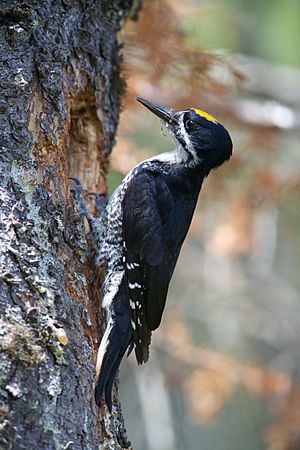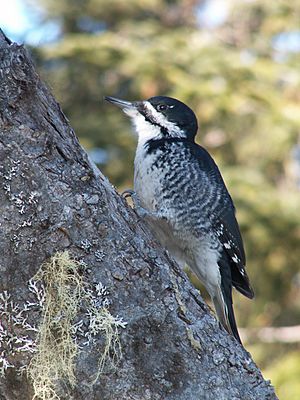Black-backed woodpecker facts for kids
Quick facts for kids Black-backed woodpecker |
|
|---|---|
 |
|
| Male in Brunswick, Vermont, United States | |
 |
|
| Female in Quebec, Canada | |
| Conservation status | |
| Scientific classification | |
| Genus: |
Picoides
|
| Species: |
arcticus
|
 |
|
| Range of P. arcticus Resident range Occasional winter range | |
The black-backed woodpecker (Picoides arcticus) is a cool bird found in the forests of North America. It's also called the Arctic three-toed woodpecker. This medium-sized woodpecker is about 23 cm (9.1 in) long.
Contents
About the Black-backed Woodpecker's Name
Scientists use a system called taxonomy to name and group all living things. The black-backed woodpecker was first described in 1832. An English naturalist named William Swainson gave it its first scientific name. He found a specimen near the Athabasca River in Canada.
Its scientific name is Picoides arcticus. The word arcticus means "northern" or "arctic" in Latin. This woodpecker is the only type of its species. This means there are no different subspecies or smaller groups of them.
What Black-backed Woodpeckers Look Like
Adult black-backed woodpeckers have black feathers on their head, back, wings, and rump. Their throat and belly are white. Their sides are white with black stripes. Their tail is black with white feathers on the outside.
There's a cool difference between males and females. This is called sexual dimorphism. Adult male woodpeckers have a bright yellow patch on top of their heads. Females do not have this yellow patch.
Unlike most other woodpeckers, this species has only three toes on each foot. Most woodpeckers have four toes. Only the related American three-toed woodpecker and Eurasian three-toed woodpecker also have three toes.
Measurements:
- Length: About 9.1 inches (23 cm)
- Weight: Between 2.1 and 3.1 ounces (61-88 grams)
- Wingspan: About 15.8 to 16.5 inches (40-42 cm)
Where They Live and How They Raise Young
Black-backed woodpeckers live in boreal forests. These are northern forests found across Canada, Alaska, and parts of the Northwestern United States. You can also find them in northern Wisconsin, Minnesota, and Upper Michigan.
These woodpeckers are special because they love burnt forests. They are called "burnt-forest specialists." They eat wood-boring beetles that feed on recently burned trees. These beetles are their main food source. They get most of their food by pecking into trees. They also pick insects off branches.
Black-backed woodpeckers usually stay in one place. But sometimes, many of them will move to new areas. This is called an irruption.
They start digging new nests in April and May. They drill a fresh hole each year in dead trees. Other birds often use these old nests. The female lays three or four eggs. Both parents take turns sitting on the eggs. The male usually sits on them at night.
When the chicks hatch, they are helpless. Both parents feed them until they are ready to leave the nest. This usually takes about 24 days.
What Black-backed Woodpeckers Sound Like
The black-backed woodpecker makes a single, sharp call. It sounds like "pik." This call is lower in pitch than the call of the American three-toed woodpecker.
See also
 In Spanish: Pico ártico para niños
In Spanish: Pico ártico para niños


